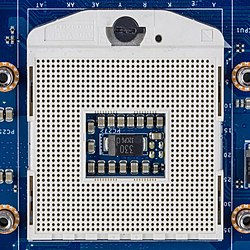 | |
| Type | rPGA |
|---|---|
| Chip form factors | Flip-chip pin grid array |
| Contacts | 988 |
| FSB protocol | DMI |
| FSB frequency | 2.5 GT/s, 4.8 GT/s [1] |
| Voltage range | Max. 5 V with max. of 500 mA per pin |
| Processor dimensions | 37.5 × 37.5 mm [2] |
| Processors |
|
| Predecessor | rPGA 988A (Socket G1) |
| Successor | rPGA 946B/947 (Socket G3) |
This article is part of the CPU socket series | |
Socket G2, also known as rPGA 988B is Intel's CPU socket used with their line of mobile Core i7, the successor to the Core 2 line, and also with several mobile Core i5 and Core i3 processors. It is based on Intel's Sandy Bridge and Ivy Bridge architecture. Like its predecessor, socket G1 systems, it can only run in dual-channel memory mode, but with data rates up to 1600 MHz (as opposed to the triple-channel mode which is unique to the LGA-1366 platform and subsequent Xeon sockets). Socket G2 CPUs are also known as FCPGA988 socket processors, which should be pin compatible with PPGA988. [3]
Contents
Although nearly all motherboards using this socket are intended for mobile products like laptops, a few desktop boards using this do exist. Supermicro, for example, produced a number of mini ITX motherboards using the QM77 chipset. [4]